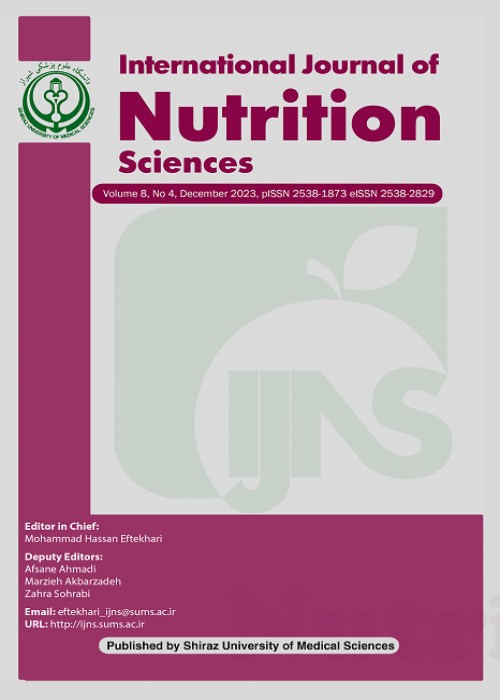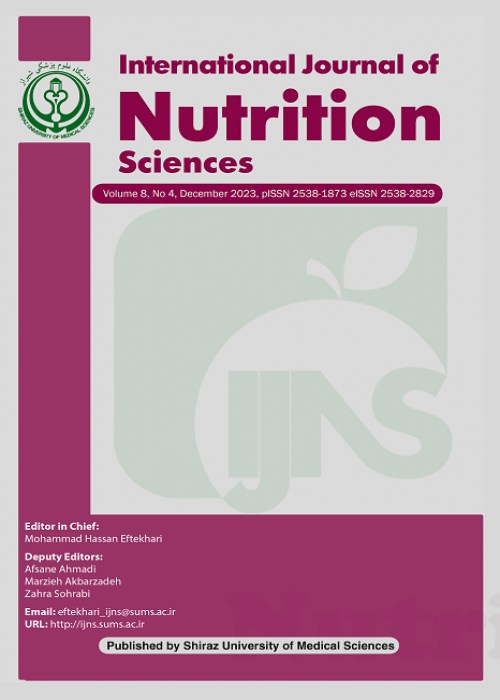فهرست مطالب

International Journal of Nutrition Sciences
Volume:8 Issue: 4, Dec 2023
- تاریخ انتشار: 1402/09/10
- تعداد عناوین: 8
-
-
Pages 197-206BackgroundMetabolic syndrome (MetS) is a significant health concern both in developed and developing countries. This cohort Prospective Epidemiological Research Study in Iran (PERSIAN) aimed to determine the association of diet quality, assessed by the Healthy Eating Index-2015 (HEI-2015) and Mediterranean Diet Score (MDS), with MetS components among individuals with MetS in Fasa, southern Iran.MethodsIn this cross-sectional study, 907 individuals with MetS aged 35-65 years were recruited from the Fasa PERSIAN Cohort Study, Fasa, Iran. The National Cholesterol Education Program Adult Treatment Panel III (ATP III) and Iranian National Committee of Obesity criteria were used to define MetS. A 125-item food frequency questionnaire wasemployed to evaluate dietary intake. The association between the quartiles of dietary scores and MetS components analyzed by Multivariate linear regression with the backward method.ResultsThe mean age of the individuals (67.3% female) was 48.75±8.22 years. After adjusting for covariates, the highest HEI-2015 quartile was positively correlated with fasting blood sugar (FBS, β=7.30, 95%CI=1.03, 13.58) and triglyceride levels (β=32.71, 95%CI=9.09, 56.33). The MDS had a significant negative association with the systolic blood pressure (SBP) in both crude and adjusted models (β=-3.14, 95%CI=-6.2, -0.019). The triglyceride (TG, β=26.008, 95%CI=4.32, 47.69) and FBS (β=5.77, 95%CI=0.057, 11.49) levels also were positively correlated with the highest MDS quartile.ConclusionThe SBP was shown to be inversely associated with the MDS, wherease higher adherence to HEI-2015 and MDS values were also linked with increased FBS and TG levels.Keywords: Mediterranean diet, Healthy eating index-2015, Metabolic Syndrome, Prospective Epidemiological Research Study in Iran (PERSIAN), Cohort study
-
Pages 207-215BackgroundPrevious studies have shown that there may be a link between metabolic syndrome (MetS) and non-alcoholic fatty liver disease (NAFLD). Therefore, the present study was designed with the aim of investigating the prevalence of metabolic syndrome in patients with NAFLD.MethodsOne hundred and fourteen patients with NAFLD were recruited to the study in Ahvaz, Iran. The Metabolic SyndromeSeverity Score (MSSS) was used in an online calculator from available information. The NAFLD determined based on clinical or laboratory symptoms, and liver ultrasonography. The determination of its severity was made using liver elastography. Univariate and multivariate analyses were used to correlate the collected parameters. Receiver operating characteristic (ROC) curve was used to evaluate the cutoff value of fibrograde and steagrade that predicts fibrosis and steatosis.ResultsTotally, 69 patients (60.5%) had MetS. The chance of higher grade of steatosis in patients with MetS was 3.76 times higher than that of patients without MetS (p=0.003). Moreover, the correlation coefficient between MSSS and osteoscore was 0.274 (p=0.023). MSSS had the predictive power to detect steagrade (0:1, 2, 3) with 83.78% sensitivity and 59.38% specificity (p=0.005) and a cutoff point of 0.45.ConclusionMSSS was shown to have the predictive power to detect steatosis grades. However, further studies are required to determine whether fibrosis has a relationship with severity of MetS.Keywords: Non-Alcoholic fatty liver disease, Metabolic Syndrome, Liver steatosis, Iran
-
Pages 216-222BackgroundDiet and nutrition are strongly implicated in the etiology of type 2 diabetes. This study has investigated whether low vitamin C and β-carotene intakes were associated with glycemic control in diabetic patients.MethodsIn a cross-sectional analysis of diabetic adult patients participating in Fasa Cohort Study, a 24-h dietary recall was used to assess intake of fruits, vegetables, vitamin C and β-carotene. The associations between vitamin C and β-carotene intakes and glycemic control were determined in 3 groups of normal glucose tolerance, pre-diabetes mellitus, and type 2 diabetes mellitus (T2DM) and the relationship between fasting blood glucose (FBS) and vitamin C and β-carotene intakes wasinvestigated.ResultsThere were no differences between groups for intake of total vitamin C and β-carotene (p>0.05). An inverse relation was recognized between intake of total vitamin C and β-carotene and FBS (p<0.05).ConclusionA negative association was observed between FBS and intake of vitamin C and β-carotene; however more experimental studies are needed to establish whether increase in intake of vitamin C and β-carotene can improve FBS level and prevent T2DM.Keywords: Vitamin C, β-carotene, Fasting blood glucose, Type 2 diabetes mellitus, Fasa Cohort Study
-
Pages 223-232BackgroundObesity is the most important risk factor for occurrence of chronic diseases. Morbid obesity could be accompanied by imbalance of body composition and serum levels of nutrients. Therefore, the aim of this study was to compare body composition and serum levels of nutrients in the bariatric surgery candidates with standard values.MethodsIn this cross-sectional study, 100 morbid obese patients (22 men and 78 women) were enrolled. Their anthropometric and biochemical measurements were evaluated based on the standard protocols. Body composition was measured using the dual X-ray absorptiometry (DEXA) method. Independent t-test was used to compare the mean of quantitative variables between genders and measurements with the standard values to estimate any deficiency.ResultsGrade 3 obesity (73%), abdominal obesity (100%), abnormal waistto-hip ratios (95%), abnormal body fat and fat-free mass percentages (100%), normal android-to-gynoid fat ratios (96%), and moderate body shape profiles (100%) were prevalent among the participants. Also, a deficiency of vitamin D (91%), vitamin B12 (19%), and iron (17% serum iron and 3% serum ferritin) was noticed. Serum levels of vitamin A (7%) and zinc (4%) were higher than normal among a part of population. There were no significant differences in the distributions of these indicators by gender.ConclusionPeople with morbid obesity had abnormal amounts of fat and muscle tissue. Also, they were deficient regarding vitamin D, vitamin B12, and iron. Moreover, vitamin A and zinc levels in some people were higher than normal. Further studies are needed to confirm these findings in larger populations.Keywords: Obesity, Anthropometry, Body Composition, Nutrients, Bariatric surgery
-
Pages 233-241BackgroundDyslipidemia puts patients at risk of cardiovascular diseases, which are the most cause of premature deaths worldwide. This study determined protective effects of resveratrol (RVL) and atorvastatin (ATV) in rats fed with a high-fat/high-fructose (HFHF) diet were compared for e treatment of atherogenic dyslipidemia.MethodsThirty-six adult male Sprague Dawley rats were divided into 4 groups, including a group fed with a standard diet and three groups fed with a HFHF diet for 12 weeks. In two groups, in addition to HFHF diet, animals received RVL (100 mg/kg) and ATV (10 mg/kg) by gavage. After 12 weeks, levels of body and heart weights, systolic blood pressure(SBP), serum biomarkers of atherogenic dyslipidemia, insulin resistance, and malondialdehyde (MDA) in the heart tissue were measured.ResultsRats received the HFHF diet showed an elevation (p<0.05) in body and heart weight, SBP, serum total triglycerides (T-TGs), total cholesterol (T-CHOL), low-density lipoprotein CHOL (LDL-C), insulin resistance, aspartate aminotransferase (AST), and tumor necrosis factor- alpha (TNF-α), and also, elevated MDA content in the heart tissue. The administration of RVL significantly reduced (p<0.05) heart weight, SBP, serum T-TGs levels, insulin resistance, TNF-α, and cardiac MDA in rats received HFHF diet. On the other hand, the administration of ATV significantly decreased (p<0.05) heart-weight, and serum levels of T-TGs, T-CHOL, LDL-C, and TNF-α.ConclusionRVL at a dose of 10 mg/kg was not a better protective medication against atherogenic dyslipidemia; but it may be applicable as a complementary medication with ATV.Keywords: Dyslipidemia, Resveratrol, Atorvastatin, Rat
-
Pages 242-251BackgroundWhile calorie restriction (CR) is a major weight loss method, alternate day fasting (ADF) has emerged as a promising alternative. Although ADF provides various health benefits, its impact on post-diet weight change remains widely unknown. This study aimed to investigate the effect of ADF on post-diet weight change and evaluate the potential factors associated with the weight change.MethodsThe following three types of dietary interventions were considered: Ad libitum (Ad lib), CR, and ADF followed by refeeding, and determining changes in weight, metabolic parameters, and gene expression levels in the adipose tissue.ResultsThe ADF group gained the maximum weight during the refeeding period. However, food intake, oxygen consumption, and locomotor activity were not significantly different between the CR and ADF groups during the refeeding period. Moreover, epididymal fat weight increased in the ADF group after refeeding. In the adipose tissues, the expression of genes related to de novo lipogenesis and triglyceride synthesis was significantly elevated in the ADF group after the dieting period.ConclusionOur results suggest that ADF could not prevent weight regain after weight loss, and increased fat synthesis may contribute to weight gain and fat accumulation after ADF. Further exploration of the post-diet weight effects would help develop sustained successful weight loss strategies.Keywords: Intermittent fasting, Adipose tissue, Weight Loss, Lipid metabolism, mice
-
Pages 252-259BackgroundThe effect of glucocorticoids on calcium balance and bone growth may lead to osteoporosis and currently glucocorticoid induced osteoporosis is one of the recognized types of osteoporosis. The present study aimed at evaluating the therapeutic effect of honey on dexamethasone-induced osteoporosis in rat model.MethodsThirty-two male rats were randomly divided into four groups including dexamethasone receiving group, physiological serum receiving group, dexamethasone and honey receiving group, and dexamethasone and alendronate group. All rats were treated for 4 weeks. At the end of the treatment period, blood was collected and the changes in blood phosphorus, calcium and alkaline phosphatase (ALP) levels were compared on the first day. Animals were sacrificed and femurs were separated for histological evaluation, while specimens were obtained from the epiphysis and metaphysis.ResultsThe positive effect of honey on prevention of osteoporosis was demonstrated, although there were no significant differences between groups regarding serum calcium. Histomorphometric parameters revealed the effective role of honey in prevention of dexamethasone-induced osteoporosis.ConclusionPrescription of dexamethasone was illustrated to reduce the histomorphometric parameters of rat femur that caused osteoporosis. On the other hand, the administration of honey with dexamethasone could largely prevent more reduction for osteoporosis. Therefore, honey is suggested as a potential treatment for glucocorticoid-induced osteoporosis.Keywords: Honey, Osteoporosis, Dexamethasone, glucocorticoids, Rat


